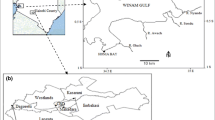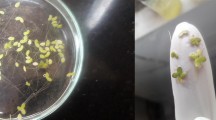Abstract
The quest for alternative sources of energy has evoked the interest in exploring potentials of living biological wastes as new energy materials. Duckweeds are produced abundantly as weeds in freshwater surface bodies and can be a source of biomass for bioenergy productions. There are approximately 40 species of this group worldwide belonging to five genera (Spirodela, Lemna, Wolfiella, Wolffia and Landoltia). The structural peculiarities (small plant size, limited life cycle, high duplication rate, etc.) and chemical characteristics (dry weight basis): 17.6–35 % (carbohydrate), 21–38 % (starch), 16–41.7 % (crude protein), 8.8–15.6 % (crude fibre) and 4.5–9 % (lipid) make duckweed as possible feedstock for biomass-based energy operations. The high contents of valuable fatty acids (palmitic acid and linoleic acid) and starch (3–75 %) in duckweed biomass suggest its utility in biorefinery. Recent lab-scale studies have shown remarkable results in terms of energy yield during the processes like anaerobic digestion, incineration, pyrolysis, gasification, oxidation, etc. Another good quality of duckweeds is its hyperaccumulative properties for a variety of water pollutants. Therefore, this group of weeds has been recommended widely for designing on-site phytoremediation system for community wastewater treatment. Thus, duckweed technology can be adopted as coupled technology to harness two environmental approaches, i.e. wastewater treatment and energy biomass production for sustainable development of the human society.


Similar content being viewed by others
References
Mafakheri F, Nasiri F (2014) Modeling of biomass-to-energy supply chain operations: applications, challenges and research directions. Energy Policy 67:116–126
Spalding-Fecher R, Williams A, van Horen C (2000) Energy and environment in South Africa: charting a course to sustainability. Energy Sustain Dev 4:8–17
Johansson B (2013) Security aspects of future renewable energy system: a short overview. Energy 61:598–605
Siirola JJ (2014) Speculations on global energy demand and supply going forward. Curr Opin Chem Eng 5:96–100
Lohan SK, Dixit J, Modasir S, Ishaq M (2012) Resource potential and scope of utilization of renewable energy in Jammu and Kashmir, India. Renew Energy 39:24–29
Ellabban O, Abu-Rub H, Blaabjerg F (2014) Renewable energy resources: current status, future prospects and their enabling technology. Renew Sust Energ Rev 39:748–764
Asif M, Muneer T (2007) Energy supply, its demand and security issues for developed and emerging economies. Renew Sust Energ Rev 11:1388–1413
Armor JN (2014) Key questions, approaches, and challenges to energy today. Catal Today 236:171–181
Ashnani MHM, Johari A, Hashim H, Hasan E (2014) A source of renewable energy in Malaysia, why biodiesel? Renew Sust Energ Rev 35:244–257
Baratieri M, Baggio P, Fiori L, Grigiante M (2008) Biomass as an energy source: thermodynamic constraints on the performance of the conversion process. Bioresour Technol 99:7063–7073
IEA (2010) Energy balances of non-OECD countries. International Energy Agency, Paris
Gupta VK, Potumarthi R, O’Donovan A, Kubicek CP, Sharma GD, Tuohy MG (2014) Chapter 2 – Bioenergy research: an overview on technological developments and bioresources. Bioenergy Res Adv Appl 23–47
Utamaa NA, Fathonia AM, Kristiantoa MA, McLellan BC (2014) The end of fossil fuel era: supply–demand measures through energy efficiency. Procedia Environ Sci 20:40–45
Cherubini F, Bird ND, Cowie A, Jungmeier G, Schlamadinger B, Woess-Gallasch S (2009) Energy- and greenhouse gas-based LCA of biofuel and bioenergy systems: key issues, ranges and recommendations. Resour Conserv Recycl 53:434–447
Venturi P, Venturi G (2003) Analysis of energy comparison for crops in European agricultural systems. Biomass Bioenergy 25:235–255
Solomon BD (2010) Biofuels and sustainability. Ann N Y Acad Sci 1185:119–134
Awudu I, Zhang J (2012) Uncertainties and sustainability concepts in biofuel supply chain management: a review. Renew Sust Energ Rev 16:1359–1368
Sims REH, Hastings AT, Schlamadinger B, Taylor G, Smith P (2006) Energy crops: current status and future prospects. Glob Chang Biol 12:2054–2076
Mari S, Antti L, Jukka R (2013) Screening of novel plants for biogas production in northern conditions. Bioresour Technol 139:355–362
Wang W (1990) Literature review on duckweed toxicity testing. Environ Res 52:7–22
Skillicorn P, Spira W, Journey W (1993) Duckweed Aquaculture. A new aquatic farming system for developing countries. The World Bank, Washington, DC
Vymazal J (2011) Plants used in constructed wetlands with horizontal subsurface flow: a review. Hydrobiologia 67:4133–4156
Sawangkeawa R, Ngamprasertsith S (2013) A review of lipid-based biomasses as feedstocks for biofuels production. Renew Sust Energ Rev 25:97–108
Cheng JJ, Stomp A (2009) Growing duckweed to recover nutrients from wastewaters and for production of fuel ethanol and animal feed. Clean Soil Air Water 37:17–26
Verma R, Suthar S (2014) Synchronized urban wastewater treatment and biomass production using duckweed Lemna gibba L. Ecol Eng 64:337–343
Bal-Krishna KC, Polprasert C (2008) An integrated kinetic model for organic and nutrient removal by duckweed-based wastewater treatment (DUBWAT) system. Ecol Eng 34:243–250
Papadopoulos FH, Tsihrintzis VA (2011) Assessment of a full-scale duckweed pond system for septage treatment. Environ Technol 32:795–804
Les DH, Crawford DJ, Landolt E, John D, Gabel JD, Rebecca KT (2002) Phylogeny and systematics of Lemnaceae, the duckweed family. Syst Bot 27(2):221–240
Landolt E, Kandeler R (1987) The family of Lemnacae—a monographic study. Vol 2. Part of the series: biosystematic investigations in the family of duckweeds (Lemnacae), vol 3 of 4. Veroffentlichungen Des Geobotanischen (pub.)
Landolt E (1992) Lemnaceae Duckweed Family Vascular Plants of Arizona. J Ariz Nev Acad Sci 1:10–14
Hillman SW (1961) The Lemnaceae or duckweeds. A review of the descriptive and experimental literature. Bot Rev 27:221–287
Ashbey E, Wangermann E (1949) Senescence and rejuvenation in Lemna minor. Nature 31:164–187
Blackburn KB (1933) Notes on the chromosomes of the duckweeds (Lemnaceae) introducing the question of chromosome size. Proc Univ Dur-Ham Phil Soc 9:84–90
Goopy PJ, Murray JP (2003) A review on the role of duckweed in nutrient reclamation and as a source of animal feed. Asian-Aust J Anim Sci 16:297–305
Chang SM, Yang CC, Sung SC (1977) The cultivation and the nutritional value of Lemnaceae. Bull Inst Chem Acad Sin 24:19–30
Kumar A, Kumar K, Kaushik N, Sharma S, Mishra S (2010) Renewable energy in India: current status and future potentials. Renew Sust Energ Rev 14:2434–2442
Saxena RC, Adhikari DK, Goyal HB (2009) Biomass-based energy fuel through biochemical routes: a review. Renew Sust Energ Rev 13:167–178
Rulkens WH, Bien JD (2004) Recovery of energy from sludge-comparison of the various options. Water Sci Technol 50:213–221
Xu J, Zhao H, Stomp AM, Cheng JJ (2012) The production of duckweed as a source of biofuels. Biofuels 3:589–601
Xiao Y, Fang Y, Jin Y, Zhang G, Zhao H (2013) Culturing duckweed in the field for starch accumulation. Ind Crop Prod 48:183–190
Zhao Y, Fang Y, Jin Y, Huang J, Bao S, Fu T, He Z, Wang F, Zhao H (2014) Potential of duckweed in the conversion of wastewater nutrients to valuable biomass: a pilot-scale comparison with water hyacinth. Bioresour Technol 163:82–91
Cui W, Xu J, Cheng JJ, Stomp AM (2010) Growing duckweed for bio-ethanol production. ASABE Paper No. 1009440. 7 p
Campanella A, Muncrief R, Harold MP, Griffith DC, Whitton NM, Weber RS (2012) Thermolysis of microalgae and duckweed in a CO2-swept fixed-bed reactor: bio-oil yield and compositional effects. Bioresour Technol 109:154–162
Liu Y, Fang Y, Huang M, Jin Y, Sun J, Tao X, Zhang G, He K, Zhao Y, Zhao H (2015) Uniconazole-induced starch accumulation in the bioenergy crop duckweed (Landoltia punctata) I: transcriptome analysis of the effects of uniconazole on chlorophyll and endogenous hormone biosynthesis. Biotechnol Biofuels 8:57
Liu Y, Fang Y, Huang M, Jin Y, Sun J, Tao X, Zhang G, He K, Zhao Y, Zhao H (2015) Uniconazole-induced starch accumulation in the bioenergy crop duckweed (Landoltia punctata) II: transcriptome alterations of pathways involved in carbohydrate metabolism and endogenous hormone crosstalk. Biotechnol Biofuels 8:64
Su H, Zhao Y, Jiang J, Lu Q, Li Q, Luo Y, Zhao H, Wang M (2014) Use of duckweed (Landoltia punctata) as a fermentation substrate for the production of higher alcohols as biofuels. Energy Fuels 28:3206–3216
Muradov N, Taha M, Miranda AF, Kadali K, Gujar A, Rochfort S, Stevenson T, Ball AS, Mouradov A (2014) Dual application of duckweed and azolla plants for wastewater treatment and renewable fuels and petrochemicals production. Biotechnol Biofuels 7:30
Gui MM, Lee KT, Bhatia S (2008) Feasibility of edible oil vs. non-edible oil vs. waste edible oil as biodiesel feedstock. Energy 33:1646–1653
Carmo AC Jr, de Souza LKC, da Costa CEF, Longo E, Zamian JR, Filho GNR (2009) Production of biodiesel by esterification of palmitic acid over mesoporous aluminosilicate Al-MCM-41. Fuel 88:461–468
Singh SP, Singh D (2010) Biodiesel production through the use of different sources and characterization of oils and their esters as the substitute of diesel: a review. Renew Sust Energ Rev 14:200–216
Long H, Li X, Wang H, Jia J (2013) Biomass resources and their bioenergy potential estimation: a review. Renew Sust Energ Rev 26:344–352
Tao X, Fang Y, Xiao Y, Jin Y, Ma X, Zhao Y, He K, Zhao H, Wang H (2013) Comparative transcriptome analysis to investigate the high starch accumulation of duckweed (Landoltia punctata) under nutrient starvation. Biotechnol Biofuels 6:72
McKendry P (2002) Energy production from biomass (part 2): conversion technologies. Bioresour Technol 83:47–54
Mohedano RA, Rejane HR, Tavares FA, Filho PB (2012) High nutrient removal rate from swine wastes and protein biomass production by full-scale duckweed ponds. Bioresour Technol 112:98–104
Rusoff LL, Blakney EW, Culley DD (1980) Duckweeds (Lemnacae Family): a potential source of protein and amino acids. J Agric Food Chem 28:848–850
Ge X, Zhang N, Phillips GC, Xu J (2012) Growing Lemna minor in agricultural wastewater and converting the duckweed biomass to ethanol. Bioresour Technol 124:485–488
Duan P, Chang Z, Xu Y, Bai X, Wang F, Zhang L (2013) Hydrothermal processing of duckweed: effect of reaction conditions on product distribution and composition. Bioresour Technol 135:710–719
Xiu SN, Shahbazi A, Croonenberghs J, Wang LJ (2010) Oil production from duckweed by thermochemical liquefaction. Energy Sources A 32:1293–1300
Huang M, Fang Y, Xiao Y, Sun J, Jin Y, Tao X, Ma X, He K, Zhao H (2014) Proteomic analysis to investigate the high starch accumulation of duckweed (Landoltia punctata) under nutrient starvation. Ind Crop Prod 59:299–308
Choy B, Reible DD (2000) Diffusion models of environmental transport. Lewis, Boca Raton
Perniel M, Ruan R, Martinez B (1998) Nutrient removal from a stormwater detention pond using duckweed. Appl Eng Agric 14:605–609
Clark PB, Hillman PF (1996) Enhancement of anaerobic digestion using duckweed (Lemna minor) enriched with iron. Water Environ J 10:92–95
Ramírez F, Seco A (2011) Minimizing the environmental effects caused by the production of bioenergy. Renew Sust Energ Rev 15:3327–3331
Muradov N, Fidalgo B, Gujar AC, T-Raissi A (2010) Pyrolysis of fast-growing aquatic biomass—Lemna minor (duckweed): characterization of pyrolysis products. Bioresour Technol 101:8424–8428
Chen Q, Jin Y, Zhang G, Fang Y, Xiao Y, Zhao H (2012) Improving production of bioethanol from duckweed (Landoltia punctata) by pectinase pretreatment. Energies 5:3019–3032
Liao R, Gao B, Fang J (2013) Invasive plants as feedstock for biochar and bioenergy production. Bioresour Technol 140:439–442
Hubenova Y, Mitov M (2012) Conversion of solar energy into electricity by using duckweed in direct photosynthetic plant fuel cell. Bioelectrochemistry 87:185–191
Bayrakci AG, Koçar G (2014) Second-generation bioethanol production from water hyacinth and duckweed in Izmir: a case study. Renew Sust Energ Rev 30:306–316
Zhu MT, Feng WY, Wang B, Wang TC, Gu YQ, Wang M (2008) Comparative study of pulmonary responses to nano- and submicron-sized ferric oxide in rats. Toxicology 247:102–111
Kurian JK, Nair GR, Hussain A, Raghavan GSV (2013) Feedstocks, logistics and pre-treatment processes for sustainable lignocellulosic biorefineries: a comprehensive review. Renew Sust Energ Rev 25:205–219
Rao PV, Baral SS, Dey R, Mutnuri S (2010) Biogas generation potential by anaerobic digestion for sustainable energy development in India. Renew Sust Energ Rev 14:2086–2094
Author information
Authors and Affiliations
Corresponding author
Rights and permissions
About this article
Cite this article
Verma, R., Suthar, S. Utility of Duckweeds as Source of Biomass Energy: a Review. Bioenerg. Res. 8, 1589–1597 (2015). https://doi.org/10.1007/s12155-015-9639-5
Published:
Issue Date:
DOI: https://doi.org/10.1007/s12155-015-9639-5




